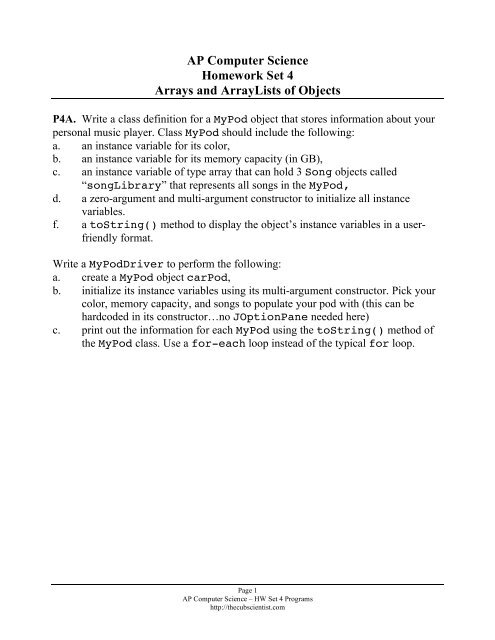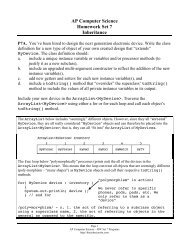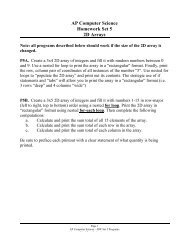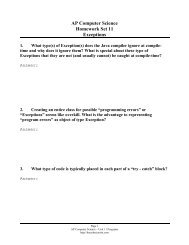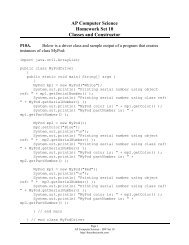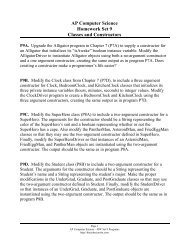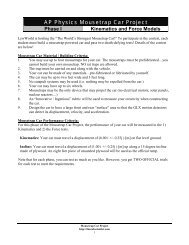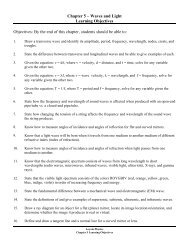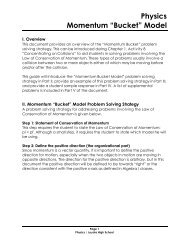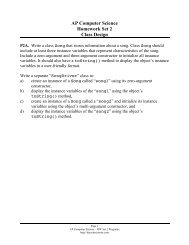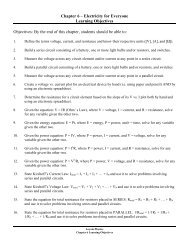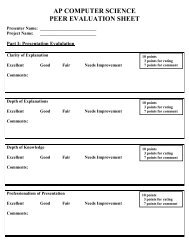AP Computer Science Homework Set 4 Arrays and ArrayLists of ...
AP Computer Science Homework Set 4 Arrays and ArrayLists of ...
AP Computer Science Homework Set 4 Arrays and ArrayLists of ...
Create successful ePaper yourself
Turn your PDF publications into a flip-book with our unique Google optimized e-Paper software.
<strong>AP</strong> <strong>Computer</strong> <strong>Science</strong><br />
<strong>Homework</strong> <strong>Set</strong> 4<br />
<strong>Arrays</strong> <strong>and</strong> <strong>ArrayLists</strong> <strong>of</strong> Objects<br />
P4A. Write a class definition for a MyPod object that stores information about your<br />
personal music player. Class MyPod should include the following:<br />
a. an instance variable for its color,<br />
b. an instance variable for its memory capacity (in GB),<br />
c. an instance variable <strong>of</strong> type array that can hold 3 Song objects called<br />
“songLibrary” that represents all songs in the MyPod,<br />
d. a zero-argument <strong>and</strong> multi-argument constructor to initialize all instance<br />
variables.<br />
f. a toString() method to display the object’s instance variables in a userfriendly<br />
format.<br />
Write a MyPodDriver to perform the following:<br />
a. create a MyPod object carPod,<br />
b. initialize its instance variables using its multi-argument constructor. Pick your<br />
color, memory capacity, <strong>and</strong> songs to populate your pod with (this can be<br />
hardcoded in its constructor…no JOptionPane needed here)<br />
c. print out the information for each MyPod using the toString() method <strong>of</strong><br />
the MyPod class. Use a for-each loop instead <strong>of</strong> the typical for loop.<br />
Page 1<br />
<strong>AP</strong> <strong>Computer</strong> <strong>Science</strong> – HW <strong>Set</strong> 4 Programs<br />
http://thecubscientist.com
P4B. Write a program that creates a “ClockStore” class that is able to hold<br />
“Clock” objects. You should reuse the Clock class from the previous chapter.<br />
The class should meet the following requirements:<br />
1. Write a class “ClockStore” that consists <strong>of</strong> a private array called<br />
“clocksInStock” that can hold 3 Clock objects.<br />
2. Create an instance <strong>of</strong> class “ClockStore” <strong>and</strong> populate it with three Clock<br />
objects using the Clock’s constructor. You set the time for each Clock.<br />
Here’s a sample demonstrating how to place a Clock in the array at position<br />
“0”:<br />
clocksInStock[0] = new Clock( 12, 30, 45 );<br />
4. Write a processor method mostSeconds() that returns index <strong>of</strong> the Clock<br />
that has the highest total seconds as calculated by the Clock method<br />
totalSeconds(). The ClockStore method mostSeconds() should<br />
have the following header:<br />
int mostSeconds()<br />
5. Write a toString() method that traverses the array <strong>of</strong> Clocks using a foreach<br />
loop. This should print the time <strong>of</strong> each clock using each Clock’s<br />
toString() method.<br />
6. Write a driver class “ClockDriver” that tests the above methods.<br />
P4C. Write a program that creates a “Roster” class that is able to hold<br />
“Student” objects. You should reuse the Student class from the previous<br />
chapter.<br />
The class should meet the following requirements:<br />
1. Write a class “Roster” that consists <strong>of</strong> a private array <strong>of</strong> Students.<br />
2. Create an instance <strong>of</strong> class “Roster” <strong>and</strong> populate it with three Student<br />
objects.<br />
3. Write a Roster findStudentWithMaxGPA() method that traverses the<br />
array with a for loop <strong>and</strong> returns out the name <strong>of</strong> the student with the max<br />
GPA.<br />
4. Write a Roster toString() method prints the name <strong>of</strong> the student with the<br />
maximum GPA (via calling the method findStudentWithMaxGPA().<br />
5. Write a driver class “RosterDriver” that tests the above methods.<br />
Page 2<br />
<strong>AP</strong> <strong>Computer</strong> <strong>Science</strong> – HW <strong>Set</strong> 4 Programs<br />
http://thecubscientist.com
P4D. Write a program that creates an ArrayList <strong>of</strong> String objects that will hold<br />
the names <strong>of</strong> members <strong>of</strong> your family. After populating the ArrayList, perform<br />
the following:<br />
a. Print the number <strong>of</strong> elements in the ArrayList using the ArrayList<br />
“.size()” method. This should be consistent with the number <strong>of</strong> names in<br />
the ArrayList.<br />
b. Use a for loop to traverse the ArrayList <strong>and</strong> print the name <strong>of</strong> each<br />
person on a separate line.<br />
c. Use a separate for-each loop to traverse the ArrayList <strong>and</strong> print the<br />
name <strong>of</strong> each person on a separate line.<br />
See LewTube for demonstrations on how to create <strong>and</strong> use <strong>ArrayLists</strong> <strong>and</strong> all <strong>of</strong><br />
its methods. The line <strong>of</strong> code below shows how to create an ArrayList <strong>of</strong><br />
Strings:<br />
ArrayList myFamily = new ArrayList()<br />
Note that you can create an ArrayList <strong>of</strong> any type. For example, you can create an<br />
ArrayList <strong>of</strong> MySongs as follows:<br />
ArrayList playList = new ArrayList()<br />
P4E. Write a program that creates an ArrayList <strong>of</strong> String objects that will hold<br />
the names <strong>of</strong> the universities to which you are applying (include at least three schools<br />
that contain 4 letters…UC’s are easy: UCLA, UCSD, UCSB, or Yale, MITT (the<br />
baseball university, or SWIM (the aquatics university). After populating the<br />
ArrayList with at least 5 schools, perform the following:<br />
a. Print the number <strong>of</strong> elements in the ArrayList. This should be consistent<br />
with the number <strong>of</strong> schools in the original ArrayList.<br />
b. Use a for-each loop to traverse the ArrayList <strong>and</strong> print the name <strong>of</strong> each<br />
school on a separate line.<br />
c. Use a for loop (not a for-each loop), to remove all the schools that have a<br />
length <strong>of</strong> 4. Make sure to test the situation where there are two consecutive<br />
schools <strong>of</strong> length “4” in your ArrayList.<br />
d. Print the number <strong>of</strong> elements in the ArrayList after the removal. Again, this<br />
should be consistent with the number <strong>of</strong> schools remaining in the list.<br />
e. Finally, print the names <strong>of</strong> the schools remaining in the list. Were all <strong>of</strong> the 4<br />
letters schools properly removed?<br />
Page 3<br />
<strong>AP</strong> <strong>Computer</strong> <strong>Science</strong> – HW <strong>Set</strong> 4 Programs<br />
http://thecubscientist.com
P4F. Let’s upgrade the MyPod class. Create a MyPod2 class that uses an<br />
ArrayList to store Songs instead <strong>of</strong> an array. Provide the same functionality as<br />
in P4A.<br />
P4G. Finally, let’s upgrade the Roster class so that it can accommodate “adding”<br />
<strong>and</strong> “dropping” Students from a roster. Write a Roster2 class called<br />
“ap<strong>Computer</strong><strong>Science</strong>” that meets the following requirements:<br />
a. Roster2 should use an ArrayList called myStudents (instead <strong>of</strong> an<br />
array) to store Student objects.<br />
b. A processor method called “addStudent” should be included that will add a<br />
given Student to the ArrayList myStudents. The method<br />
addStudent should have the following header:<br />
public void addStudent ( Student newStudent )<br />
Note that the addStudent method will ultimately call the ArrayList’s<br />
.add() method since Student objects are stored in the ArrayList <strong>of</strong><br />
myStudents.<br />
c. A processor method in the Roster class called “dropStudent” with the<br />
following header:<br />
public void dropStudent ( String lastName )<br />
The method dropStudent should remove the student with the given last<br />
name. For example, the following line <strong>of</strong> code will remove the student “Lew”<br />
from the ArrayList myStudents:<br />
period1.dropStudent( “Lew” );<br />
d. Write a Roster2Driver that performs the following:<br />
i. Creates a Roster2 object called “ap<strong>Computer</strong><strong>Science</strong>”,<br />
ii. Adds three students using the “addStudent” method,<br />
iii. Prints “period1” using Roster2’s toString() method to verify<br />
all “added” Students have indeed been added,<br />
iv. Calls the “dropStudent” method to drop one <strong>of</strong> the students in the<br />
ArrayList myStudents (i.e. any one <strong>of</strong> the Students in the<br />
class), <strong>and</strong><br />
v. Prints “ap<strong>Computer</strong><strong>Science</strong>” again to view the revised list <strong>of</strong><br />
Students in the “ap<strong>Computer</strong><strong>Science</strong>”.<br />
Page 4<br />
<strong>AP</strong> <strong>Computer</strong> <strong>Science</strong> – HW <strong>Set</strong> 4 Programs<br />
http://thecubscientist.com
By the end <strong>of</strong> the lesson students should be able to:<br />
a. Write a class definition that includes instances <strong>of</strong> another class (class<br />
composition)<br />
b. Write an object method whose output depends on the object’s instance<br />
variables.<br />
c. Use arrays <strong>and</strong> <strong>ArrayLists</strong> in a class <strong>and</strong> be able to use either a for or<br />
for-each loop to traverse the array or ArrayList.<br />
Page 5<br />
<strong>AP</strong> <strong>Computer</strong> <strong>Science</strong> – HW <strong>Set</strong> 4 Programs<br />
http://thecubscientist.com


